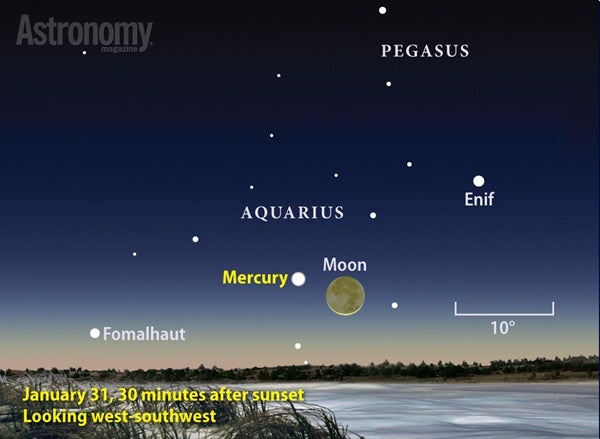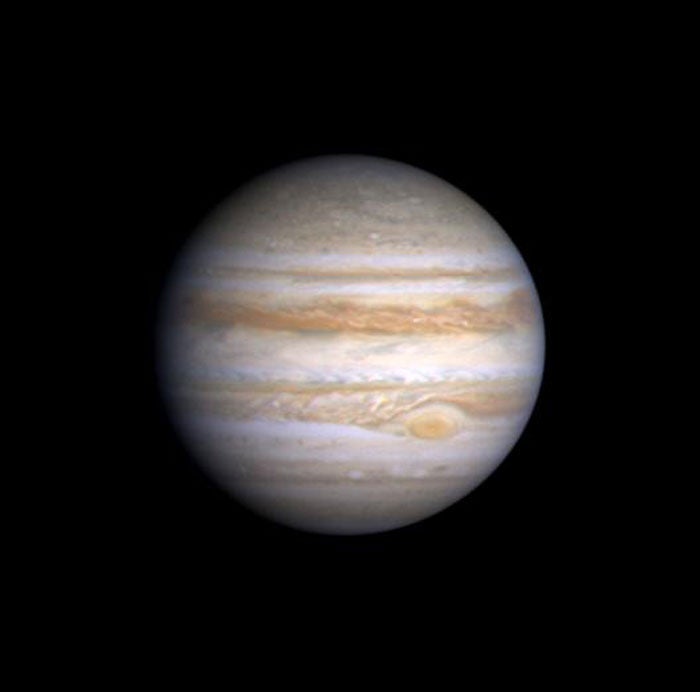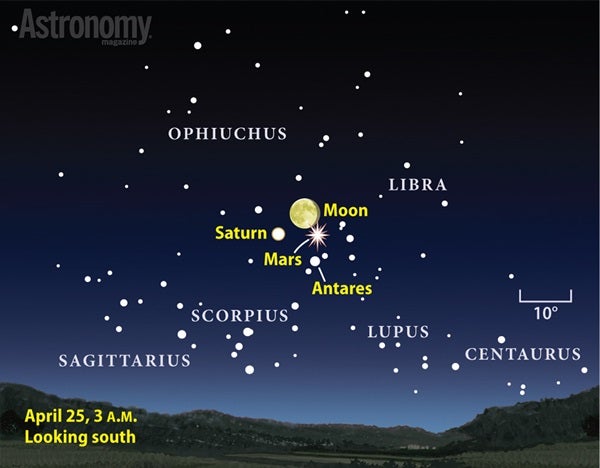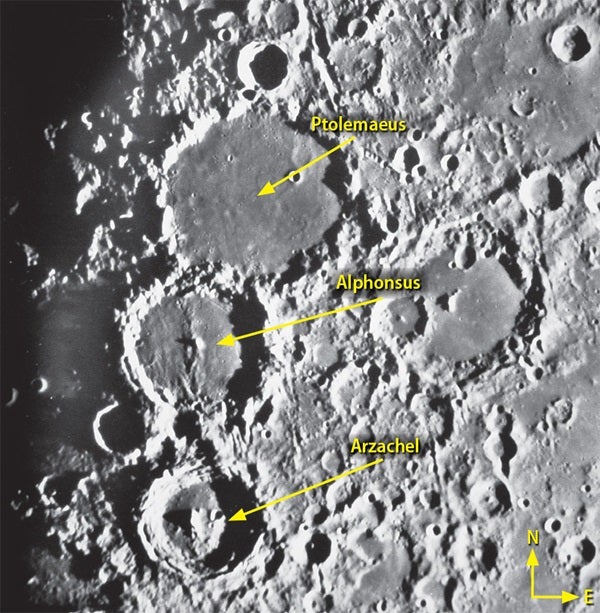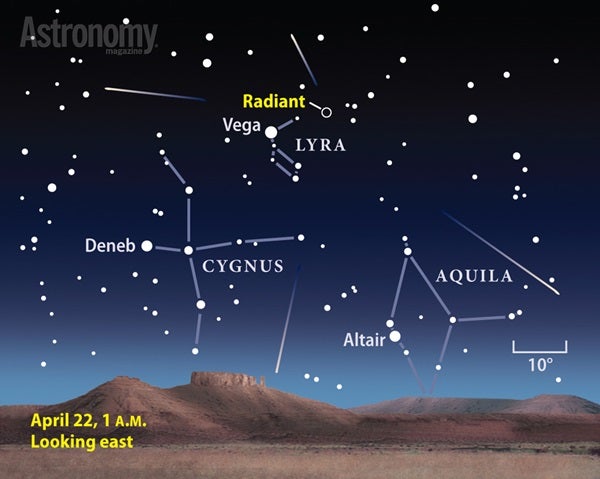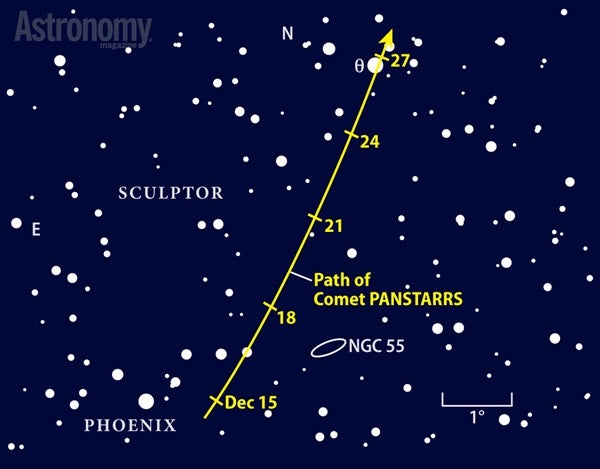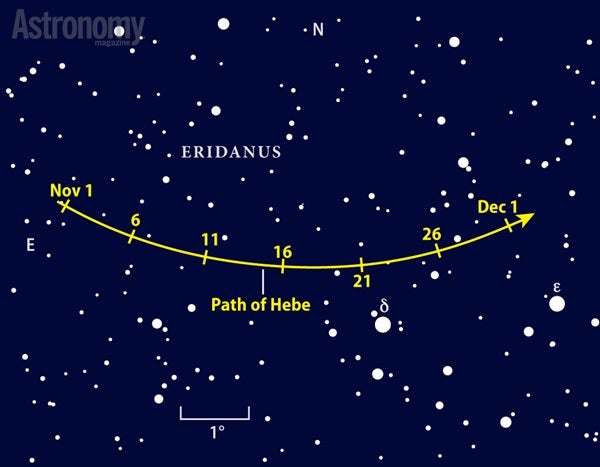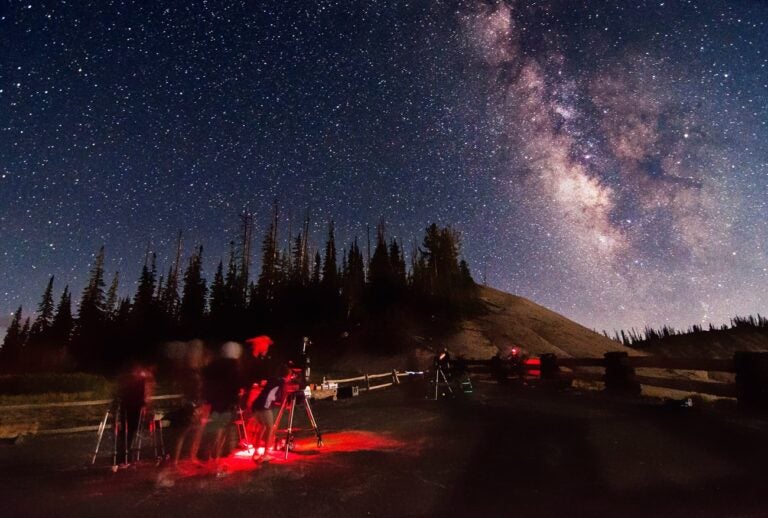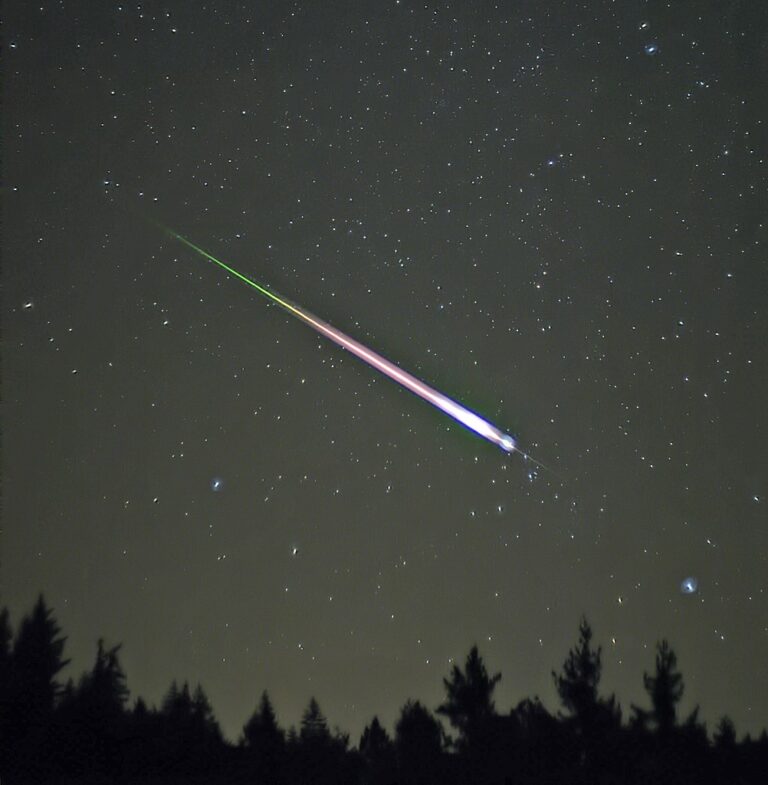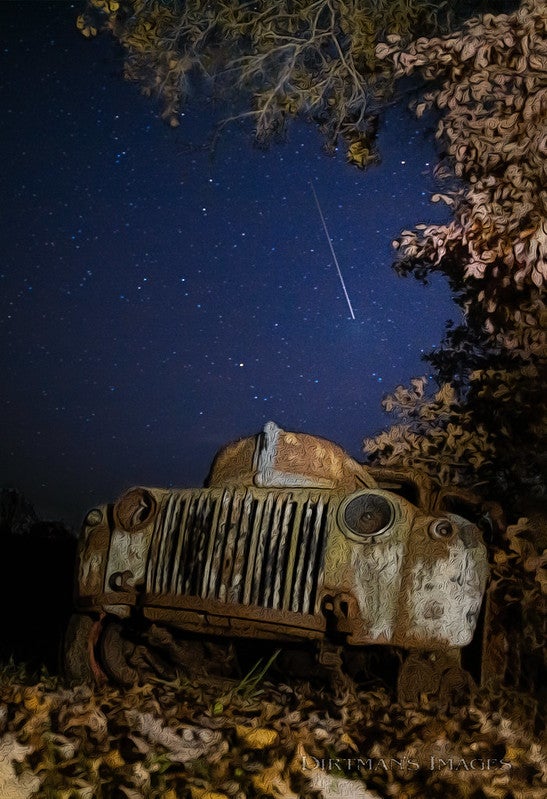But we’ll begin our solar system tour with a more challenging object. Mercury has its best evening appearance of the year during April. That’s because in early spring the ecliptic — the path of the Sun across our sky that the planets follow closely — tips steeply to the western horizon after sunset, so a planet’s separation from our star translates largely into altitude.
As the innermost planet, however, Mercury still never escapes the twilight glow. At greatest elongation April 18, it lies 20° east of the Sun and stands 10° high in the west-northwest 45 minutes after sunset. The world glows at magnitude 0.1 and shows up easily against the darkening sky. A telescope reveals Mercury’s 8″-diameter disk, which appears slightly more than one-third illuminated.
Of course, you don’t have to limit your viewing to one night. Mercury remains a tempting target from roughly 10 days before greatest elongation until a week after. Pay particular attention on the 8th when a waxing crescent Moon passes by. The planet shines at magnitude –1.0 and lies 8° to our satellite’s lower right.
As twilight fades, observers will shift their attention to Jupiter. The giant planet reached opposition and peak visibility in March, but its appearance in April hardly suffers. The biggest difference is its improved visibility: By the time darkness falls, Jupiter already has climbed 40° high in the southeast.
The giant world spends the month in southern Leo, some 15° east-southeast of 1st-magnitude Regulus. At magnitude –2.4, Jupiter outshines the Lion’s luminary by more than 30 times.
The planet’s atmosphere sports two dark bands that straddle a brighter equatorial zone. The zone rotates about five minutes faster than the rest of the planet, so it’s little wonder that turbulence reigns at the belts’ edges. Many features change in one rotation.
As you gaze at Jupiter through a telescope, you can’t help but see its entourage of four bright moons. Typically these satellites appear against the black of space near the planet. Once each orbit, however, a moon passes in front of Jupiter (a transit), and observers can watch its disk and inky-black shadow (a shadow transit) cross the planet’s face. A half-orbit later, the moon disappears behind the gas giant’s disk (an occultation) and then enters the planet’s shadow (an eclipse).
On the action-packed night of April 6/7, Jupiter viewers can witness all four kinds of events. Innermost Io begins to transit Jupiter at 9:52 p.m. EDT, and its shadow follows 40 minutes later. Keep your eyes on Europa west of the planet — Jupiter occults this moon at 10:48 p.m. Ganymede, the solar system’s largest satellite, then lies east of Jupiter but is closing rapidly. It starts to transit the gas giant at 1:01 a.m.
There’s more on tap if you stay up to the wee hours. At 2:54 a.m., Europa emerges from Jupiter’s shadow about one planet radius east of the limb. Ganymede then appears more than halfway across the jovian disk. Its large shadow first touches the cloud tops at 3:45 a.m. Ganymede’s transit ends a half-hour later, by which time Jupiter is sinking low in the west for observers in eastern North America.
Although the evening hours belong to Jupiter, the parade of planets starts to pick up around midnight local daylight time. Mars leads the way. It rises in the southeast just before midnight April 1 and about two hours earlier by month’s end. Backyard observers have waited two years for Mars to return to glory. The Red Planet reaches opposition in late May, so both its brightness and apparent size through a telescope ramp up quickly this month.
The planet’s added luster in April reflects its shrinking distance from Earth. This also causes a rapid growth in apparent size. If you target the Red Planet through a scope on April 1, you’ll see a disk 12″ across. Repeat the observation on the 30th, and Mars will span 16″.
Don’t be fooled, however. This is still small, and surface details appear subtle. Your local observing conditions play a big role in how clearly features show up. For a good look, wait until Mars climbs at least 20° high roughly two hours after it rises. The best views come when the ruddy world lies highest in the south shortly before twilight starts to paint the sky.
A day on Mars lasts 37 minutes longer than one on Earth. So, if you observe at roughly the same time each night, a feature at the center of the martian disk during one observing session will take an extra 37 minutes to reach the same position the next night. This doesn’t make a huge difference in the planet’s appearance, but the slow drift adds up. In the course of a week, the central meridian shifts a bit more than 60°, significantly changing the features visible.
At the beginning of April, Sinus Meridiani and Acidalia Planitia are prominent shortly after Mars rises. Syrtis Major, the planet’s most conspicuous dark feature, rotates into view at the end of April’s first week. It lingers into the latter half of the month if you observe shortly before dawn.
It is currently summer in the Red Planet’s northern hemisphere. Can you see remnants of the melting north polar cap? Also keep an eye on Syrtis Major and other dark markings looking for changes in size or shading. Early observers thought vegetation or rising sea levels might cause these seasonal changes; astronomers now suspect windblown dust and sand are the culprits.
Saturn lies in southern Ophiuchus all month. This area receives a visitor April 25 when a waning gibbous Moon slides past. Our satellite stands north of Mars and Saturn while Antares lies to their south. All four objects appear within a 10°-wide circle.
Although a telescope delivers wonderful views of Jupiter and Mars this month, neither compares with Saturn. In mid-April, the distant world shows a mostly featureless disk measuring 18″ across surrounded by a spectacular ring system that spans 40″ and tilts 26° to our line of sight. Saturn’s appearance will improve slowly in the coming weeks as it heads toward opposition in early June.
A telescope also reveals a number of moons. You can see the planet’s biggest and brightest satellite, 8th-magnitude Titan, through any instrument. It passes due north of the gas giant April 3 and 19 and due south April 11 and 27. A trio of 10th-magnitude moons — Tethys, Dione, and Rhea — lurk closer to Saturn and will show up through 4-inch scopes.
The same aperture brings in two-faced Iapetus in early April. This moon glows at 10th magnitude when its brighter half points earthward at greatest western elongation April 5. It then stands 9′ from Saturn. It dims by a magnitude by the time it passes 2′ north of the planet April 25.
Do you remember why Mercury looks so nice these April evenings? It’s because the ecliptic angles steeply to the western horizon after sunset in early spring. Unfortunately, the opposite holds true in the east before dawn, which renders the remaining planets hard to see in morning twilight.
On April 1, Venus lies a degree or so above the eastern horizon a half-hour before sunrise. At magnitude –3.8, it shines brightly enough to show up if you have a flat horizon and pristine conditions. And you might glimpse Neptune at the end of April. It appears 5° high in the east as twilight begins, but its 8th-magnitude glow will be a challenge to see.
As the evening sky darkens April 9, the crescent Moon stands about 15° high in the west. Pull your attention away from the chain of craters arrayed along the terminator — the line that divides lunar day from night — and hunt instead for Lacus Spei (Lake of Hope).
Start at the prominent Mare Crisium (Sea of Crises) near the northeastern limb. Head a full mare diameter north, and you’ll land on the timeworn crater Messala. Billions of years of bombardment have rounded and softened its once-sharp rim. Just a short distance to the north is the smaller crater Mercurius, which sports a taller and sharper rim indicating a more recent impact. When the atmosphere steadies, you’ll notice slumped terraces at the base of its walls. Although smaller craters typically hold their form, larger ones collapse inward under the force of gravity.
Lunar cartographers dubbed the flat gray splotch that lies between these craters the Lake of Hope, which marked a refreshing change from the darker names they applied to many of the maria. Two small craters on the lake’s eastern shore appear quite sharp, signifying that they are the relatively new kids on the block.
Keep watching Lacus Spei to see how it darkens with each passing night. As the Sun rises higher in the lunar sky, shadows disappear, and the surrounding terrain brightens quickly. This gives the impression that the lava floor has darkened, but it’s only a contrast effect.
Look for another transition as the Lake of Hope approaches the limb. Starting April 14 and running through Full Moon on the 22nd, our sister world appears to be rotating to the northeast. Astronomers call this motion libration, and it results from the Moon’s changing position relative to Earth’s orbit. During this week, Luna climbs north of our joint orbit around the Sun, so from our perspective, its northern hemisphere tilts away.
The April 22 Full Moon nearly ruins this year’s peak of the annual Lyrid meteor shower. The best views likely will come just before twilight begins. The meteors appear to radiate from the constellation Lyra, which then lies nearly overhead, and the Moon then hangs low in the southwest. If you face away from our satellite, you should see a few “shooting stars.”
You might have just as much luck the morning of April 12. That’s when the minor Virginid shower peaks. With the Moon setting just after midnight, observers at dark sites could see up to five meteors per hour coming from near Spica.
| WHEN TO VIEW THE PLANETS |
||
| Evening Sky |
Midnight | Morning Sky |
| Mercury (west) |
Mars (southeast) |
Venus (east) |
| Jupiter (southeast) |
Jupiter (southwest) |
Mars (southwest) |
| |
Saturn (southeast) |
Saturn (south) |
| |
Neptune (east) |
|
| |
||
What do comets and galaxies have in common? When viewed through a 4-inch telescope under a dark sky, the solar system wanderers and distant island universes often appear similar in brightness and shape. The resemblance inspired avid comet hunter Charles Messier to catalog non-stellar objects to help reduce false alarms of comet discoveries.
Comet Ikeya-Murakami (P/2010 V1) should glow around 10th magnitude this month, a near match for many of the galaxies in Messier’s catalog. What’s more, it lies among the background stars of Leo, within 40° of more than 20 Messier galaxies.
The shape of Ikeya-Murakami won’t remind too many observers of a galaxy, however. Instead of being round or slightly oval, it should look dagger-shaped with a bulbous end. Imagers might capture a short greenish or bluish gas tail sticking out the southeastern end. Meanwhile, the fan-shaped dust tail turns almost edge-on to our line of sight and appears as a colorless streak to the west of the nucleus. The southern edge of the comet’s head, or coma, will be sharper than the northern flank. To see the most detail, use as much magnification as your scope and the night’s conditions allow.
Ikeya-Murakami’s trajectory in April carries it to the southeast across western Leo and its conspicuous Sickle asterism. It slides a mere 0.5° from 1st-magnitude Regulus, the Lion’s heart, on April 24 and 25. Although the close pass makes the comet easy to locate, it will be hard to see in the glare of the blue-white luminary.
When astronomers discovered the first asteroids 200 years ago, the objects were hailed as new planets. Within a century, so many of them existed (more than 400) that they were demoted to minor planets and regarded as celestial vermin. And now they are hot topics again. NASA’s Dawn spacecraft currently orbits 1 Ceres, and both NASA and its Japanese counterpart have missions to visit asteroids and return samples to Earth. (See “New missions mine asteroid secrets” on p. 28.)
Moreover, evidence suggests that 6 Hebe could be the parent body of 40 percent of the meteorites that fall to Earth. As luck would have it, Hebe reached opposition in March and is now well placed for viewing. You can find the 10th-magnitude asteroid in eastern Leo through a small telescope.
Hebe sits a couple of degrees from 2nd-magnitude Denebola, the Lion’s tail star. Use the chart below to find the asteroid’s approximate position and then sketch four or five stars around that location. Return to the same spot on the next clear night to find which object moved, confirming its identity as Hebe.
Martin Ratcliffe provides planetarium development for Sky-Skan, Inc. from his home in Wichita, Kansas. Meteorologist Alister Ling works for Environment Canada in Edmonton, Alberta.


